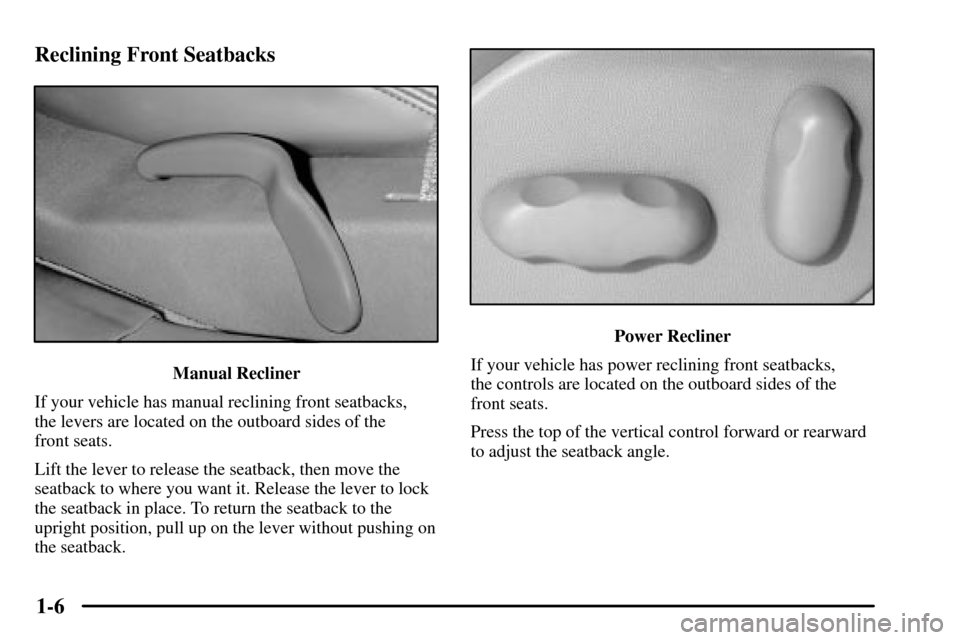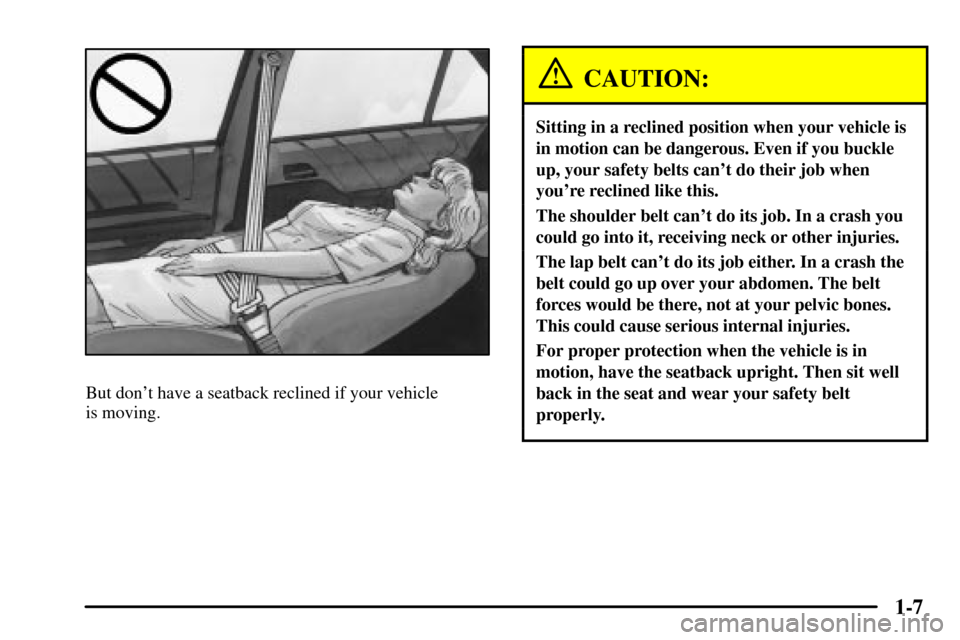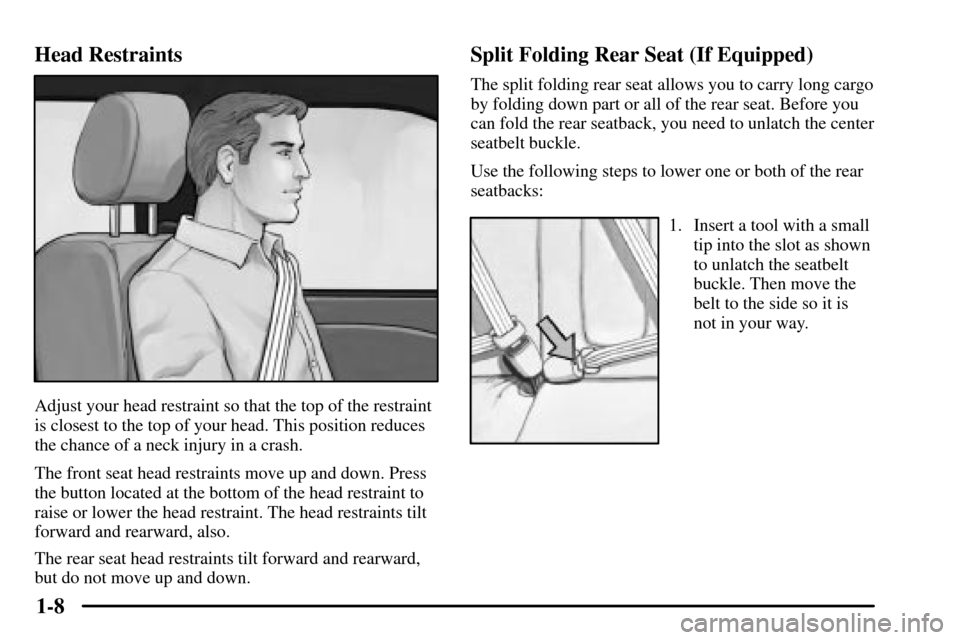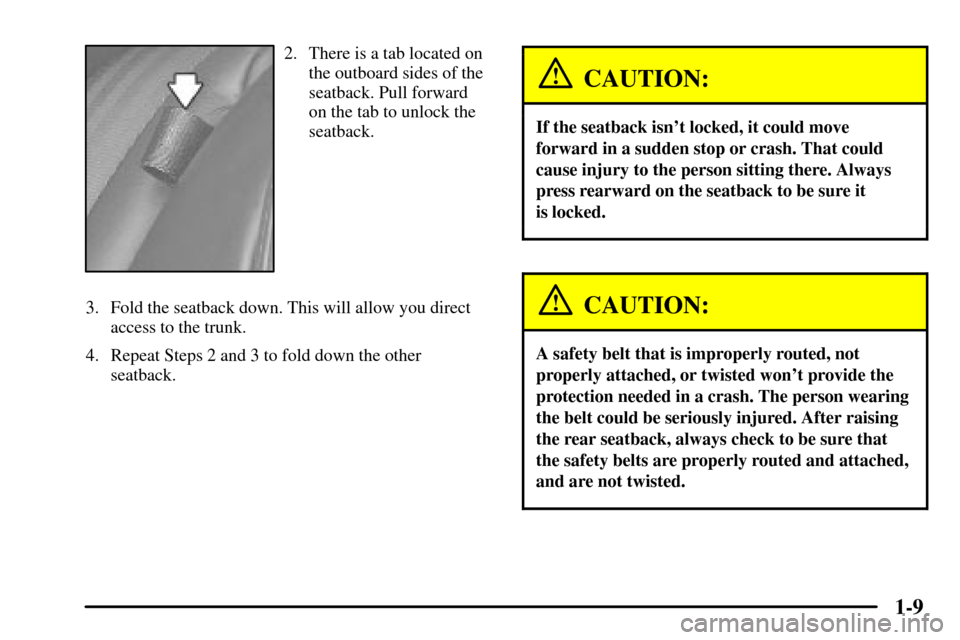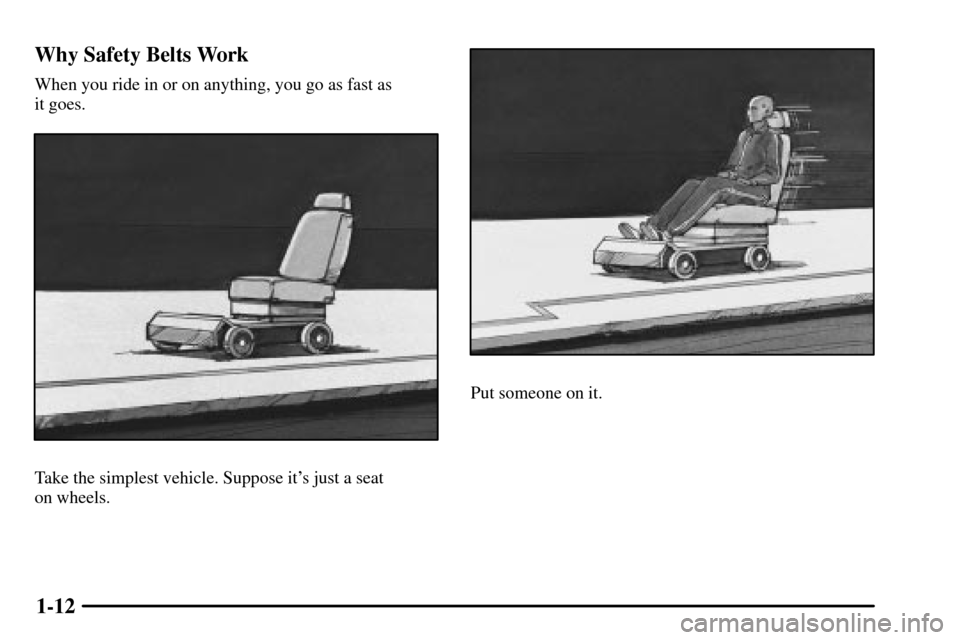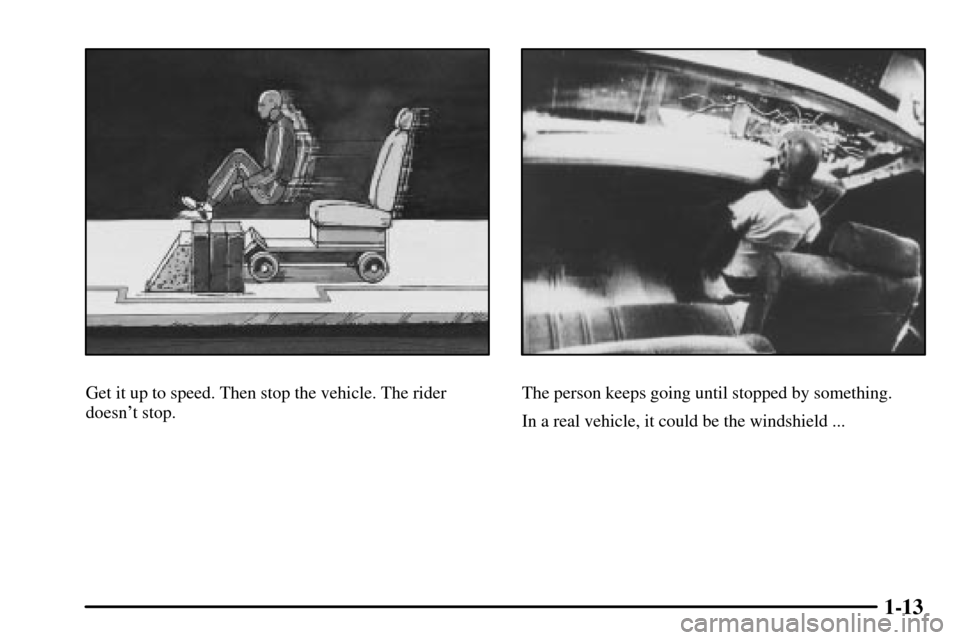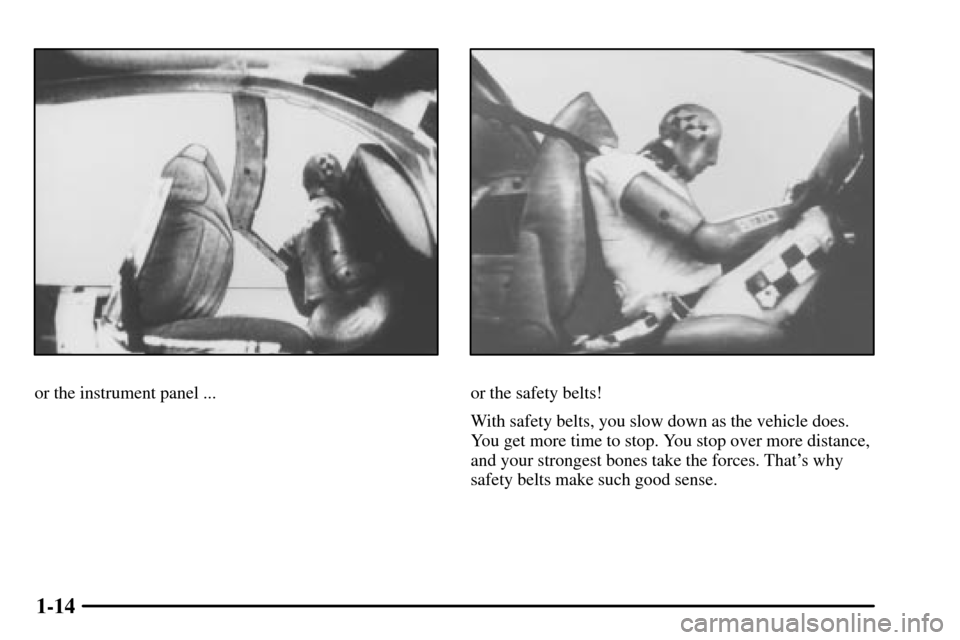CADILLAC CTS 2003 1.G User Guide
CTS 2003 1.G
CADILLAC
CADILLAC
https://www.carmanualsonline.info/img/23/7863/w960_7863-0.png
CADILLAC CTS 2003 1.G User Guide
Trending: seats, wheel size, emergency towing, change wheel, jump cable, metric, key battery
Page 11 of 435
1-5 Heated Front Seats (If Equipped)
If your vehicle is equipped
with heated front seats, the
buttons are located on the
climate control panel.There is a button for the driver and one for the front
passenger. Each button has the following three settings:
LO, HI and off. The active setting appears on the
climate control panel display. The LO setting warms the
seatback and cushion until the seat approximates normal
body temperature. The HI setting has a slightly higher
temperature.
To turn on the heated seats, press the button once. The
seat will heat to the HI setting. Press the button again to
switch to the LO setting. Pressing the button a third time
turns the system off.
The heated seats can only be used when the ignition is
turned on. When the vehicle is turned off, the heated
seats automatically turn off. If you wish to have the
heated seats on once the vehicle is restarted, press the
button again.
Page 12 of 435
1-6 Reclining Front Seatbacks
Manual Recliner
If your vehicle has manual reclining front seatbacks,
the levers are located on the outboard sides of the
front seats.
Lift the lever to release the seatback, then move the
seatback to where you want it. Release the lever to lock
the seatback in place. To return the seatback to the
upright position, pull up on the lever without pushing on
the seatback.
Power Recliner
If your vehicle has power reclining front seatbacks,
the controls are located on the outboard sides of the
front seats.
Press the top of the vertical control forward or rearward
to adjust the seatback angle.
Page 13 of 435
1-7
But don't have a seatback reclined if your vehicle
is moving.
CAUTION:
Sitting in a reclined position when your vehicle is
in motion can be dangerous. Even if you buckle
up, your safety belts can't do their job when
you're reclined like this.
The shoulder belt can't do its job. In a crash you
could go into it, receiving neck or other injuries.
The lap belt can't do its job either. In a crash the
belt could go up over your abdomen. The belt
forces would be there, not at your pelvic bones.
This could cause serious internal injuries.
For proper protection when the vehicle is in
motion, have the seatback upright. Then sit well
back in the seat and wear your safety belt
properly.
Page 14 of 435
1-8 Head Restraints
Adjust your head restraint so that the top of the restraint
is closest to the top of your head. This position reduces
the chance of a neck injury in a crash.
The front seat head restraints move up and down. Press
the button located at the bottom of the head restraint to
raise or lower the head restraint. The head restraints tilt
forward and rearward, also.
The rear seat head restraints tilt forward and rearward,
but do not move up and down.
Split Folding Rear Seat (If Equipped)
The split folding rear seat allows you to carry long cargo
by folding down part or all of the rear seat. Before you
can fold the rear seatback, you need to unlatch the center
seatbelt buckle.
Use the following steps to lower one or both of the rear
seatbacks:
1. Insert a tool with a small
tip into the slot as shown
to unlatch the seatbelt
buckle. Then move the
belt to the side so it is
not in your way.
Page 15 of 435
1-9
2. There is a tab located on
the outboard sides of the
seatback. Pull forward
on the tab to unlock the
seatback.
3. Fold the seatback down. This will allow you direct
access to the trunk.
4. Repeat Steps 2 and 3 to fold down the other
seatback.
CAUTION:
If the seatback isn't locked, it could move
forward in a sudden stop or crash. That could
cause injury to the person sitting there. Always
press rearward on the seatback to be sure it
is locked.
CAUTION:
A safety belt that is improperly routed, not
properly attached, or twisted won't provide the
protection needed in a crash. The person wearing
the belt could be seriously injured. After raising
the rear seatback, always check to be sure that
the safety belts are properly routed and attached,
and are not twisted.
Page 16 of 435
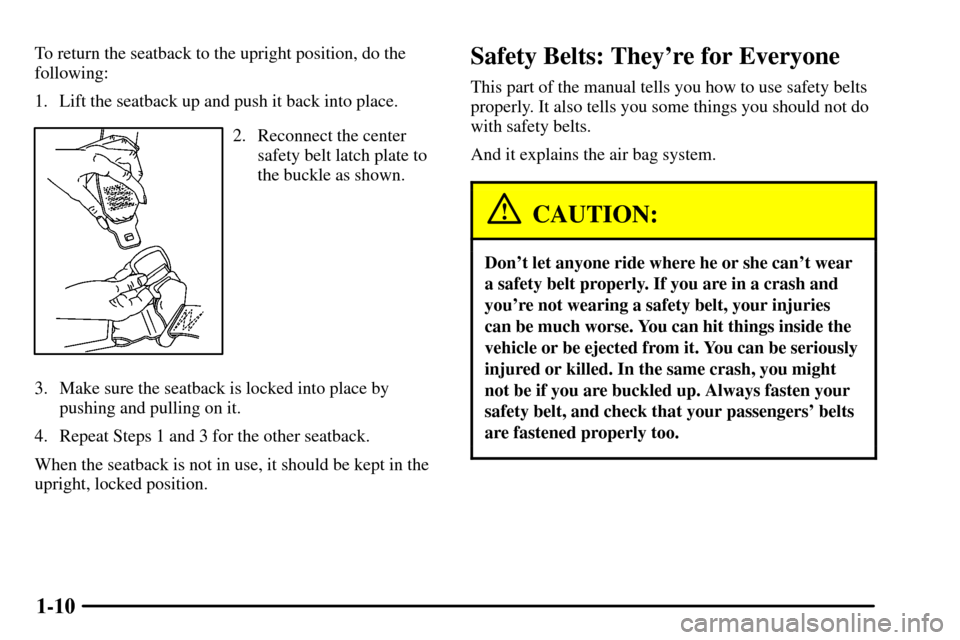
1-10
To return the seatback to the upright position, do the
following:
1. Lift the seatback up and push it back into place.
2. Reconnect the center
safety belt latch plate to
the buckle as shown.
3. Make sure the seatback is locked into place by
pushing and pulling on it.
4. Repeat Steps 1 and 3 for the other seatback.
When the seatback is not in use, it should be kept in the
upright, locked position.
Safety Belts: They're for Everyone
This part of the manual tells you how to use safety belts
properly. It also tells you some things you should not do
with safety belts.
And it explains the air bag system.
CAUTION:
Don't let anyone ride where he or she can't wear
a safety belt properly. If you are in a crash and
you're not wearing a safety belt, your injuries
can be much worse. You can hit things inside the
vehicle or be ejected from it. You can be seriously
injured or killed. In the same crash, you might
not be if you are buckled up. Always fasten your
safety belt, and check that your passengers' belts
are fastened properly too.
Page 17 of 435
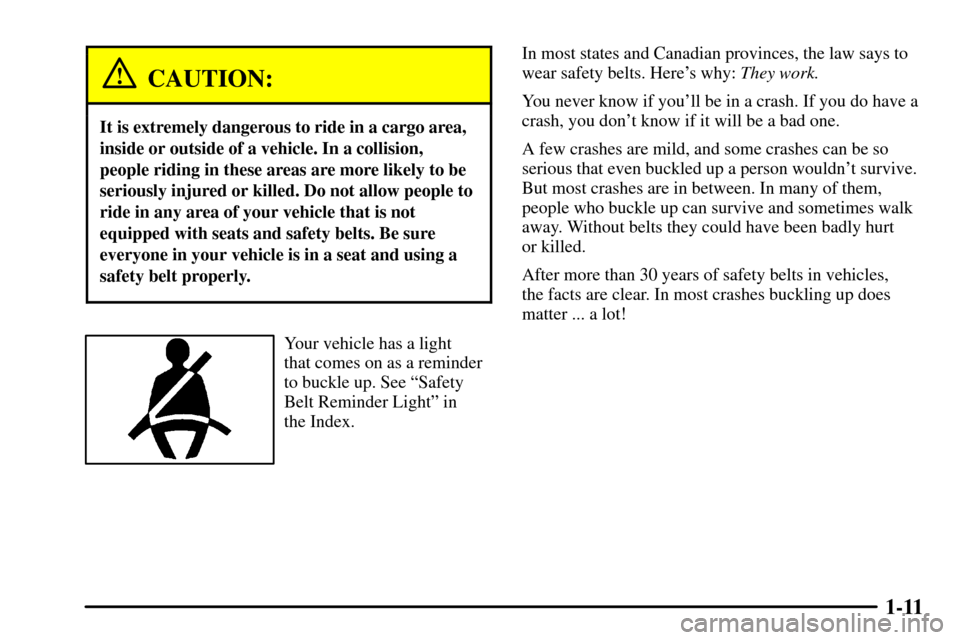
1-11
CAUTION:
It is extremely dangerous to ride in a cargo area,
inside or outside of a vehicle. In a collision,
people riding in these areas are more likely to be
seriously injured or killed. Do not allow people to
ride in any area of your vehicle that is not
equipped with seats and safety belts. Be sure
everyone in your vehicle is in a seat and using a
safety belt properly.
Your vehicle has a light
that comes on as a reminder
to buckle up. See ªSafety
Belt Reminder Lightº in
the Index.In most states and Canadian provinces, the law says to
wear safety belts. Here's why: They work.
You never know if you'll be in a crash. If you do have a
crash, you don't know if it will be a bad one.
A few crashes are mild, and some crashes can be so
serious that even buckled up a person wouldn't survive.
But most crashes are in between. In many of them,
people who buckle up can survive and sometimes walk
away. Without belts they could have been badly hurt
or killed.
After more than 30 years of safety belts in vehicles,
the facts are clear. In most crashes buckling up does
matter ... a lot!
Page 18 of 435
1-12 Why Safety Belts Work
When you ride in or on anything, you go as fast as
it goes.
Take the simplest vehicle. Suppose it's just a seat
on wheels.
Put someone on it.
Page 19 of 435
1-13
Get it up to speed. Then stop the vehicle. The rider
doesn't stop.The person keeps going until stopped by something.
In a real vehicle, it could be the windshield ...
Page 20 of 435
1-14
or the instrument panel ...or the safety belts!
With safety belts, you slow down as the vehicle does.
You get more time to stop. You stop over more distance,
and your strongest bones take the forces. That's why
safety belts make such good sense.
Trending: fuel additives, engine oil, automatic transmission, windshield wipers, CD player, maintenance schedule, oil dipstick

